|
|
|
|
|
|
|
Achi-Kochi Japan
Showing many places to visit and foods to eat in Japan
|
|
|
|
|
|
|
|
|
|
|
|
|
Japan
> Kanto region
> Nikko
|
|
|
|
|
|
|
Nikko City
Tochigi Pref., Kanto ( Achi-Kochi Japan )
|
|
|
|
|
|
|
|
|
|
|
|
|
( "Achi-Kochi" in Japanese means "Here and there" in English. )
Nikko City, Tochigi Pref., Kanto
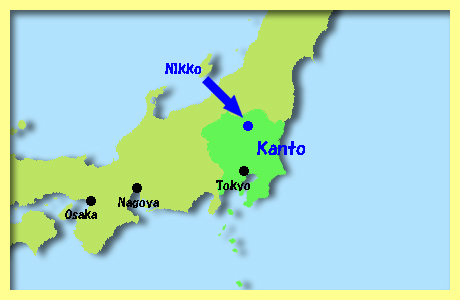
Nikko City, Tochigi Prefecture, is located in the north of Kanto Region and so popular among many tourists. There are famous shrines and temples, some of which are included in one of UNESCO World Heritage sites. Also there are waterfalls, lakes, wetland, mountains amd Onsen hot springs.
In addition, it is relatively easy to go to Nikko from Tokyo. By trains, It takes a few hours from Tokyo to Nikko.
|
|
Nikko Toshogu ( Shrine )

The most famous and most popular destination in the city is Nikko Toshogu ( Shrine - above ), which constitutes one of UNESCO World Heritage sites. In the shrine, there are five structures designated as National Treasures of Japan as well as three more designated National Important Cultural Properties of Japan.
|
|
Goho-to ( Pagoda )
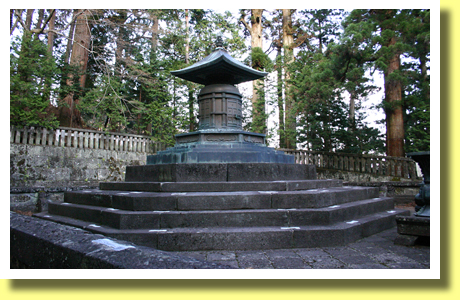
In the inmost of Nikko Toshogu, there is the Goho-to ( Two Story Pagoda - above ), which is the tomb of Ieyasu Tokugawa who established Tokugawa Shogunate in Edo ( now Tokyo ) in A.D.1603. Ieyasu Tokugawa died in A.D.1616 and his son and the 2nd shogun, Hidetada Tokugawa founded Nikko Toshogu in A.D.1617 to enshrine his father, the 1st shogun. As for Tokugawa Shogunate, please refer A History of Japan vol.2 Samurai Age.
|
|
Yomeimon ( Gate )
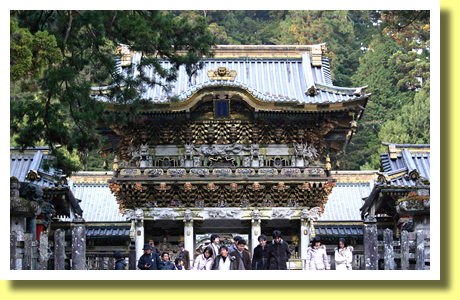
Most of the remaining structures of Nikko Toshogu were built in A.D.1636 by the 3rd shogun, Iemitsu Tokugawa, the son of Hidetada and the grandson of Ieyasu. Also Yomeimon gate ( above ) was built in A.D.1636 by Iemitsu. Yomeimon gate is one of the structures designated National Tresures of Japan.
|
|
Elephant in Relief
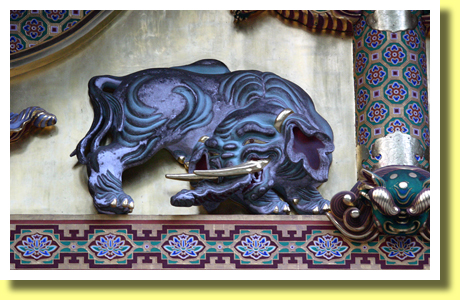
The structures of Nikko Toshogu are covered with colourful and elaborate reliefs and carvings such as the above - an elephant in relief. It is said that the elephant was designed by Tanyu Kano, one of the most famous painters in Japan at the time, though he had never seen an elephant. They say that an elephant came to Japan in A.D.1597, unfortunately five year before Tanyu Kano was born.
|
|
Three Wise Monkeys
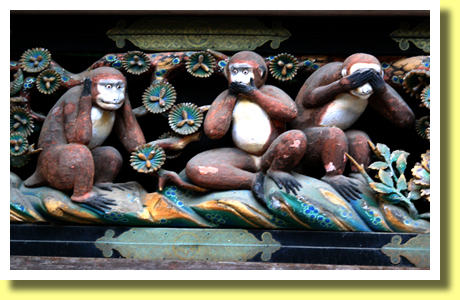
Among many reliefs and carvings seen in Nikko Toshogu, the most famous and popular is "Three Wise Monkeys" ( above ), which shows "Mizaru, Kikazaru, Iwazaru" in Japanese. "Zaru" is Japanese macaques, one of wild animals seen all over Japan except Hokkaido.
"Mizaru" means "a monkey who sees no evil", "Kikazaru" means "a monkey who hears no evil" and "Iwazaru" means "a monkey who speaks no evil". Some say that the origin of the maxim is the Analects of Confucious, a Chinese philosopher.
|
|
Futarasan Jinja ( Shrine )
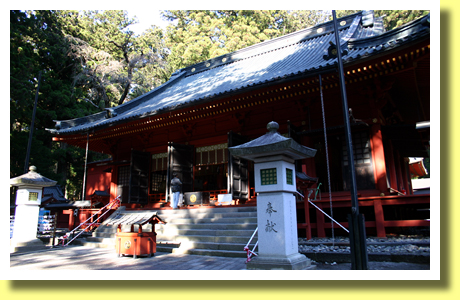
Futarasan Jinja ( Shrine - above ) constitutes one of UNESCO World Heritage sites as well as Nikko Toshogu and Rinno-ji ( Temple ). It is said that Futarasan Jinja was founded in A.D.767. Futarasan Jinja, as the center of the mountain worship, was originally dedicated to Futarasan Mountain ( now called "Nantai Mountain" ). Many tourists visit Nikko Toshogu, Futarasan Jinja and Rinno-ji.
|
|
Kegon Falls
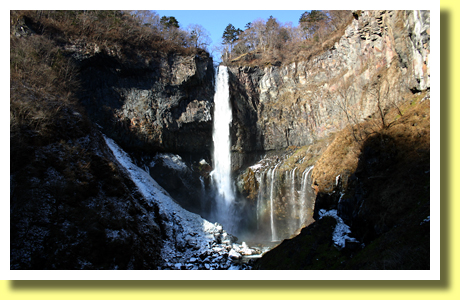
Kegon Falls ( above ), located in Nikko National Park, is one of the most beautiful falls in Japan. The height of the main falls is about 97m. It is said that Nantai Mountai ( Futarasan Mountain ) erupted about 7,000 years ago in Jomon Period and its lava changed the flow of a river, which formed Kegon Falls.
At the foot of the waterfall there is a observatory platform, from which tourists could enjoy viewing the falls so much. Admission fee
would be worth paying.
|
|
Nihonzaru ( Japanese macaque )
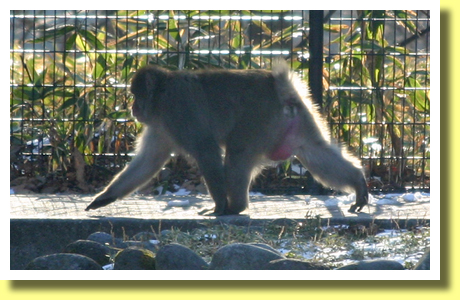
Kegon Falls are surrounded by forests and rich in nature. So visitors could see wild residents such as the above - Nihonzaru ( Japanese macaque ) who sometimes behave naughty. It seems that they do not know the maxim shown by Three Wise Monkeys in Nikko Toshogu. Visitors are expected to be careful about Nihonzaru not only around Kegon Falls but also in shrines and temples. Tourists are not expected to feed them as well.
|
|
Lake Chuzenji and Nantai Mountain
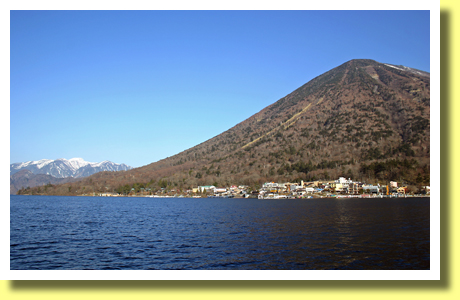
The above shows Lake Chuzenji and Nantai Mountain, both of which are located in Nikko National Park and popular among tourists. Lake Chuzenji was formed about 20,000 years ago by an eruption of Nantai Mountain. As a summer resort, there were villas owned by foreign people around the lake especially in the 2nd half of the 19th century in Meiji Period.
Nantai Mountain used to be called Futarasan, to which Futarasan Jinja was dedicated. The mountain, an active volcano, has paths to walk up to the top. Especially in summer, the mountain paths are so popular.
|
|
Senjogahara
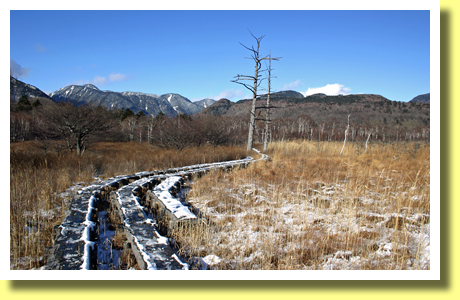
Also popular among hikers are walking paths in Senjogahara ( above ), which is a part of Nikko National Park and one of the Ramsar Wetlands. Senjogahara, marshes at this moment, used to be a lake formed by an eruption of Nantai Mountain.
The name "Senjogahara" in Japanese means "battle field", though people have not fought there but it is said that the deities of Nantai Mountain and Akagi Mountain fought each other in Senjogahara and Lake Chuzenji belonged to the winner, Nantai Mountain.
|
|
Yuba

Nikko is famous for Yuba ( bean curd skin ), which is made from boiled soy milk. In Nikko, traditional local dishes of Yuba ( above ) are sashimi and fried. Yuba served in Nikko is one of local specialty dishes.
|
Copyright (c) 2021 Achi-Kochi Zanmai Co., Ltd.
|